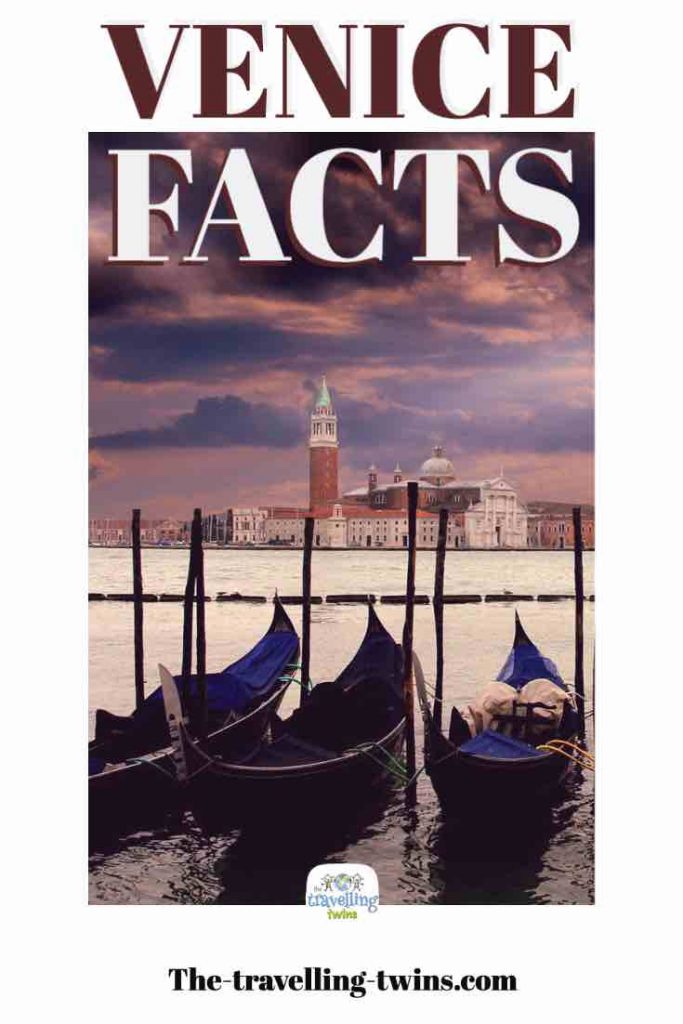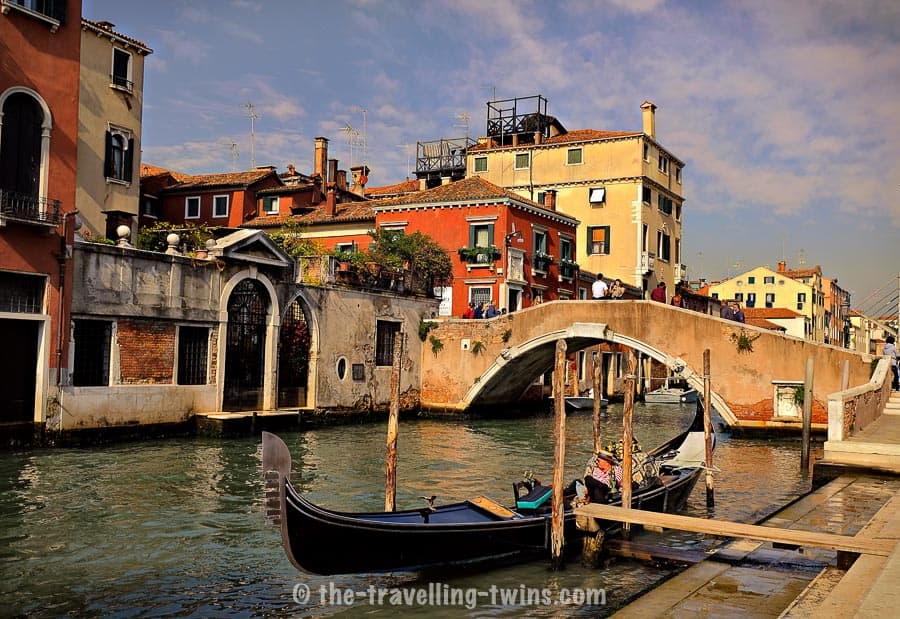The very name Venice is evocative of Europe’s richest history. Add to this, its beautiful townscape of canals and bridges and it’s easy to see why Venice is one of the most fascinating cities in Italy we have visited. Venice was called different names like – “the Floating City”, “Sereniccima” and “City of Canals” of Course. If you want to learn facts about Venice, that you probably didn’t know read below.

The Origins of Venice – how old is Venice?
The Venetian islands were first inhabited in the 5th century when the last European Byzantine Christians settled there using the lagoon as defence from the Barbarians of the Dark Ages. The legendary date of the foundation of Venice is 25 March 421 CE.
Venice was founded on 118 islands (flat islets), located in a lagoon at the northern tip of the Adriatic. The builders built walls of hard stone on thick larch piles. The method turned out to be so durable that many 400 year old buildings survive today.
Most of the island city already existed in its present shape before 1500. It was not until the 20th century that more houses were built on the outskirts of the city.
The leader of the Venetian Republic was the Doge of Venice, and he was elected! The Venetians first elected their Doge in 697. The Doge was elected for life, first by the general assembly of adult citizens of the republic (arengo), then by the electoral college. The last Doge abdicated in 1797, the Republic of Venice was dissolved as Napoleon took the city.
Tourism and the Changing Economy of Venice
In the last 50 years, many Venetians have moved to the mainland as their homes are transformed into hotels and guesthouses for tourists. With the exodus of a residential economy, many ordinary shops are also disappearing: bakeries, greengrocers, grocery stores are replaced by international luxury brands and souvenir shops.
As the population of Venice falls, the cost of living rises for those remaining, which accelerates the change. The current population of about fifty thousand is falling by about one thousand a year – residents are outnumbered more than five hundred to one by the 25-30 million annual tourists. If this trend continues then by 2030 there will be no residents in the city, only tourists.
It comes as no surprise that Venice is on the UNESCO World Heritage Site List for both its cultural heritage and its natural site.

Gondolas and Gondoliers in Venice
- Gondolas are the best known icon of the city; a great attraction of Venice is a gondola cruise on the canals and gondoliers are an integral part of the city’s panorama.
- There are only about 400 licensed gondoliers and the profession usually passes from father to son. At the present, there is only one female gondolier: Giorgia Boscolo, is the daughter of a gondolier herself, she is as well the first woman in this profession.
- Gondoliers apparently are very well paid and it’s very difficult to become a gondolier. Every year only 40 people can attend the 400 hour-long gondolier training. When a licensed gondolier retires or dies, the license would go to his heir who may accede to the position or nominate a replacement.
- Gondolas used to be colourful as competing Venetians competed with lush decoration until it all got too much and in the 16th century, a new law was passed, forcing all the gondolas to be black.
- The average gondola is made from eight different types of wood, has a length of 11 meters and weighs around 600 kilos. The line of the boat is asymmetrical, so the boat travels straight although the gondolier stands off centre.
- Gondolas now are for the tourists, locals use Vaporetti – the city’s waterborne bus system.
Venice is Sinking
Due to a combination of situations including tectonic plate movement, modern ground water pumping (now stopped), and occasional freak high tides at the top of the Adriatic Sea, Venice is sinking. It has been estimated that Venice sank about 3 inches (7 cm) in the thousand years before 1900, rising to nearly ten inches (25 cm) in just one hundred years of the twentieth century. At present Venice sinks by an average of about one and a half inches (4 cm) in ten years, some parts rather faster.
Floods in Venice
The increasing water level and frequent flooding of the city mean that the ground and first floors of many tenement houses are irretrievably damaged already and the costs of maintaining houses continues to grow. The last big flood took place in November 2019 when the excess water level was measured at more than six feet (1.84 metres). This was the highest in fifty years but with the future effects of Global Warming added to all the causes described above, these events are predicted to become more common in the future.
Despite modern engineering works to protect Venice, some experts predict that the city of Venice will be gone by the year 2100.
Canals and bridges in Venice
The City of Venice is built over 118 islands and it has 150 interconnected canals, the most important of which is the Grand Canal which has S shape.
The oldest and only bridge over the Grand Canal until 1854 was Ponte di Rialto (Rialto bridge) The city currently has 400 bridges some of the historic and some modern – almost all with steps.
 Venice viewed from the International Space Station
Venice viewed from the International Space Station
Venice don’t have really streets rather pavements as all the public transport in Venice happens via canals. Though one of the narrowest street in the world which has 53cm wide is in Venice.
Building Design in Venice
Reflecting the historic economy of the city as a rich trading centre of both Byzantine and later Ottoman wealth between Constantinople/Istanbul and Europe, A typical palazzo served as a residential house, a warehouse of goods and a trading office.
Most houses have three floors. The kitchen was either located on the ground floor for access to drinking water, or on the top floor to prevent smells from spreading throughout the house.
Venice is a city with few streets, and those that exist are poor relations to the canals. To reflect the city’s function of marine trade, house facades facing canals were architecturally richly decorated, whereas the facades facing squares and streets were more modest.
How Venice was build
Sewage and Waste in Venice
The city has over 7,000 septic tanks which treat sewage sufficiently so that the effluent may be released back into the canals without pollution. The city is tidal, so that the canal water is flushed through with fresh water twice-daily.
Rubbish collection vehicles in Venice are of course special boats, which work together with hand trolleys, adapted with a kind of rocker system on the wheels so they can be manoeuvred up and down the city’s numerous steps. There is of course a strictly enforced recycling system, and other specialist boats are adapted to empty sludge and sediment to maintain the city’s septic tanks.
Famous people in Venice
- Marco Polo – Marco Polo was born in Venice in a merchant family. Together with his father and uncle, he reached China, traversing the silk route. He was one of the first Western people who reach China.
- Antonio Vivaldi – Antonio Lucio Vivaldi was born in 1678 in Venice. He is one of the greatest violinists and composers of Italian origin. Vivaldi was a Catholic priest and red hair, which is why he was called Il Prete Rosso, meaning “Red Priest”. Antonio Vivaldi was born into contact with music. His father played the violin in Basilica San Marco and taught his son to play this instrument
- Giacomo Casanova, a European adventurer, traveller and writer, was born in Venice. He is the author of memoirs in which he vividly describes life in eighteenth-century European capitals. In his diaries, Casanova included numerous descriptions of love conquests, this made him remember and the fact that his name in many languages became a synonym for a seducer.
- Canaletto – Canaletto was a nickname of his early eighteenth-century painter and printmaker’s real name was, surprisingly, Canal! His work which combines realism with fantasy is found in the world’s richest collections.
The Oldest Cafe and the First in the world
The oldest cafe in the world in the Venetian Cafe Florian, which was founded on 29 December 1720 by Florian Francesconi. The restaurant is located in the arcades of the Prosecutor’s Office. Legend has it that in Cafe Florian, in rococo halls and small rooms decorated with frescoes, mirrors and polished wood, Carlo Goldoni and Casanova, Goethe and Foscolo, Proust and D’Annunzio as well as Lord Byron, Rousseau, Rubenstein and Modigliani met to enjoy their coffee and chocolate.
The first public casino in the world was opened in the city of Venice in 1638
The Oldest Movie Festival – Venice Film Festival
The festival was founded in 1932 by Count Giuseppe Volpi di Misurata. The event does not take place in the historic centre of Venice but on the island of Lido, in late August or early September. The main prizes of the festival are the Golden Lion for the best film and the Volpi Cup for the best actor and actress. The Venice Film Festival is considered to be the oldest film event in the world.
Venice’s Mythical Patrons
Venice has two patrons, St. Theodore and St. Mark. St. Theodore of Amasea was the patron saint of Venice under the Byzantine Empire, while St. Mark was proclaimed the patron saint of independent Venice. Relics of St Mark are buried in the Basilica facing the square, both of which bear his name. In 828, Venetian merchants stole the saint’s remains from Alexandria and brought them here. Both saints are commemorated by columns, together called the Sea Gate of Venice, in the place where executions once took place.
The coat of arms of Venice is a winged lion holding an open book with the words of the angel engraved on it. The winged lion is of course the ancient Christian symbol of St. Mark the evangelist.
St. Mark’s Basilica is decorated with four bronze horses, originally drawing a Roman chariot known as a quadriga.
The present horses are a copy of the original which originally adorned the Basilica and have now been moved to the Museo Marciano. The sculpture was brought in 1204 from the Constantinople Hippodrome by order of the Doge Enrico Dandolo. The four horses were made of gilded bronze, most probably in the 2nd century BC.
Venice and Quarantine
The word quarantine comes from ‘quaranti giorni’ means 40 days. Venice required Forty days period of isolations for all the ships before crew and passengers was allowed ashore during the Black Death plague.
Venice Carnival
The Venice Carnival is as famous as that of the very different carnival of Rio. It’s an annual celebration before Ash Wednesday. The roots of carnival tradition are reaching as far as 1162 when people started dancing on St Mark’s Square in order to celebrate the Venetian Victory. Carnival was outlawed in 1797 but returned in 1979 and now brings even more people to Venice.
Part of Venetian Carnival are masks which used to help Venetians to hide their identity and socialize during the carnival without judgment. In 1608, the Council of Ten approved wearing masks only during the carnival. Those who broke the law were heavily punished. Punishments ranged from two years in prison to public beating and binding to the pillar of shame
Interesting Facts about Venice – Pin it



